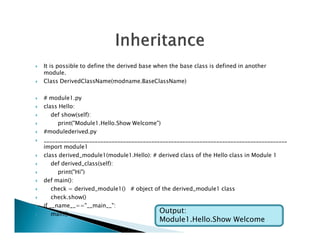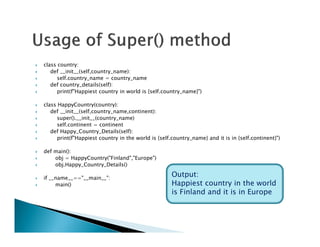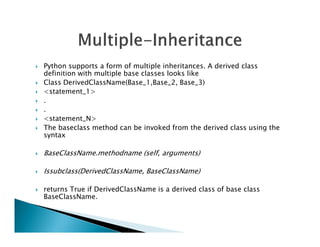Object_Oriented_Programming_Unit3.pdf
- 12. you must specify self explicitly when defining the method, you don’t include it when calling the method
- 15. Classes are defined using keyword “Class” followed by user defined “ClassName” and a colon. Variables are also called attributes Functions are also called methods. Functions are also called methods. Syntax: class className: <statement-1> <statement-2> ; <statement-n>
- 16. class Mobile: def __init__(self, name): self.mobile_name=name print("Constructor") def receive_msg(self): print(f"Receive Message from {self.mobile_name}") def send_msg(self): print(f"Send Message from {self.mobile_name}") def main(): def main(): nokia = Mobile("Nokia") nokia.receive_msg() nokia.send_msg() if __name__=="__main__": main() Output: Constructor Receive Message from Nokia Send Message from Nokia •Class Mobile has 2 methods: -Receive_msg() - Send_msg() •Self has no meaning in Python. •It is used to improve readability. •__init__ function is called when an object is instantiated
- 17. Object refers to a particular instance of a class. It contains variables and methods defined in the class. Class objects support 2 kinds of operations. ◦ A. Attribute references – The names in class are referenced by objects and are called attribute references. There are two objects and are called attribute references. There are two kinds of attribute references. A. Data attributes – Variables defined within methods are called instance variables / data attributes which are used to store data. B. Method attributes – Functions that are inside a class and are referenced by objects of a class. B. Instantiation – Act of creating an object from a class.
- 18. class student: def __init__(self,name,marks): self.name = name self.marks = marks def check_pass_fail(self): if self.marks >= 40: return True else: return False •Student1 and Student2 are the objects of Student Class. •Student1 is instantiated with name as Harry and marks 30 •Student2 is instantiated with name as Jane and marks 99 •Whenever you call a method using an object, def main(): student1 = student("Harry", 30) student2 = student("Jane", 99) did_pass = student1.check_pass_fail() print(did_pass) did_pass = student2.check_pass_fail() print(did_pass) if __name__=="__main__": main() •Whenever you call a method using an object, the object is automatically passed in as the first parameter to the self parameter variable Output False True
- 19. class Birds: def __init__(self, bird_name): self.bird_name = bird_name def flying_birds(self): print(f"{self.bird_name} flies above clouds") def non_flying_birds(self): print(f"{self.bird_name} is the national bird of Australia") def main(): vulture=Birds("Griffon Vulture") Crane = Birds("Common Crane") Emu = Birds("Emu") vulture.flying_birds() Crane.flying_birds() Emu.non_flying_birds() if __name__=="__main__": main() Output: Griffon Vulture flies above clouds Common Crane flies above clouds Emu is the national bird of Australia vulture, Crane and Emu are the objects of class Birds
- 20. Only one constructor can be defined per class Syntax: def __init__(self,parameter_1,….parameter_n) It defines and initializes the instance variables It is called as soon as an object of a class is It is called as soon as an object of a class is instantiated. All the data attributes of a class are initialised in the init function itself.
- 21. An object can be passed as an argument to a calling function class Music: def __init__(self,song,artist): self.song=song self.artist=artist def print_track_info(vocalist): Output: Song is Boy With Love Artist is BTS2 def print_track_info(vocalist): print(f"Song is {vocalist.song}") print(f"Artist is {vocalist.artist}") singer = Music("Boy With Love","BTS") print_track_info(singer)
- 22. class sum: def __init__(self,num1,num2): self.num1 = num1 self.num2 = num2 self.sum =" " def add_sum(self): self.sum = self.num1 + self.num2 return self Output: 9 1787802679712 True return self def main(): number =sum(4,5) returned_object = number.add_sum() print(returned_object.sum) print(id(returned_object)) print(isinstance(returned_object,sum)) if __name__=="__main__": main() •id(object) is a function that is used to find the identity of the location of the object in memory •Isinstance(object,classinfo) is a function that returns a boolean stating if the object is an instance of class or not.
- 23. class Dog: kind ='Canine' def __init__(self,name): self.dog_name=name Class Attributes: Are Class variables that is shared by all objects of a class. Data Attributes Are instance variables unique to each object of a d=Dog('Fido') e=Dog("Buddy") print(f"{d.kind}") print(f"{e.kind}") print(f"{d.dog_name}") print(f"{e.dog_name}") Output: Canine Canine Fido Buddy unique to each object of a class.
- 24. Encapsulation -> Information hiding Abstraction -> Implementation hiding It is the process of combining variables that store data and methods that work on those variables into a single unit called class. class foo: def __init__(self,a,b): self.a = a Output: 7 self.a = a self.b = b def add(self): return self.a + self.b foo_object =foo(3,4) print(foo_object.add()) The internal representation of the foo class is hidden outside the class -> Encapsulation The implementation of add() function is hidden from the object. -> Abstraction
- 25. class Demo: def __init__(self): self.nonprivate="I am not a private instance" self.__private="I am a private instance" def display_privateinstance(self): print(f"{self.__private} used within the method of a class") def main(): def main(): demo_obj = Demo() demo_obj.display_privateinstance() print(demo_obj.nonprivate) # print(demo_obj.__private) if __name__=="__main__": main() Output: I am a private instance used within the method of a class I am not a private instance
- 26. The private instance variables cannot be accessed outside the class, but only through a method defined inside the class In Python, an identifier with double underscore is treated as private. Name mangling is intended to give the class an easy way to define private instance variables and methods class Student: def __init__(self, name): self.__name = name // private attribute s1 = Student("Santa") print(s1._Student__name) //Access using _class__private attribute
- 27. The class that is used as the basis for inheritance is called a superclass or base class. A class that inherits from a base class is called a subclass or derived class. The base class and derived class exhibit “is a” relationship in inheritance Eg: Sitar is a stringed instrument Eg: Sitar is a stringed instrument Syntax of derived class: Class DerivedClassName(BaseClassName): <statement-1> . . <statement-N>
- 28. It is possible to define the derived base when the base class is defined in another module. Class DerivedClassName(modname.BaseClassName) # module1.py class Hello: def show(self): print("Module1.Hello.Show Welcome") print("Module1.Hello.Show Welcome") #modulederived.py ______________________________________________________________________________________ import module1 class derived_module1(module1.Hello): # derived class of the Hello class in Module 1 def derived_class(self): print("Hi") def main(): check = derived_module1() # object of the derived_module1 class check.show() if __name__=="__main__": main() Output: Module1.Hello.Show Welcome
- 29. class someclass(object): # this is derived out of the "class object" def __init__(self): print("Constructor") def someclass_function(self): print("Hello India") •All class except “Class object” are derived classes. •Class object is the base of inheritance hierarchy and hence has no derived classes. def main(): obj = someclass() obj.someclass_function() if __name__=="__main__": main() has no derived classes. •Classes without baseclassname are derived from the class object.
- 30. class cricket: def __init__(self,IPLteam,owner,times_won): self.IPLteam = IPLteam self.owner = owner self.times_won = times_won def IPLOwner(self): print(f"The IPL team {self.IPLteam} is owned by {self.owner}") class derived_cricket(cricket): class derived_cricket(cricket): def IPLresults(self): print(f"The IPL team {self.IPLteam} has won {self.times_won}") def main(): cricket_fans=derived_cricket("KKR","SRK", 9) cricket_fans.IPLOwner() cricket_fans.IPLresults() if __name__=="__main__": main() Output: The IPL team KKR is owned by SRK The IPL team KKR has won 9
- 31. Derived_cricket is the derived class and cricket is the base class Derived class inherits variables and methods of base class __init__() method is also derived from base class. Derived __init__() method is also derived from base class. Derived class has access of __init__() method of the base class. The base class has 3 data attributes, IPLteam, owner and times_won. It has a method IPLOwner Derived class has access to the data attributes and methods of the base class.
- 32. In Single Inheritance, built-in super() function is used to refer to base class without explicitly naming it. If derived class has __init__() method and needs to access the base class __init__() method explicitly, then this is done using super(). If the derived class needs no attributes from base class, then we do not need to use super() method to invoke base class __init__() method. need to use super() method to invoke base class __init__() method. Super().__init__(base_class_parameters) Its usage is as below. Class DerivedClass(BaseClass): def__init__(self, derived_class_params, base_class_params) super().__init__(base_class_params) self.derived_class_params = derived_class_params
- 33. class country: def __init__(self,country_name): self.country_name = country_name def country_details(self): print(f"Happiest country in world is {self.country_name}") class HappyCountry(country): def __init__(self,country_name,continent): super().__init__(country_name) self.continent = continent self.continent = continent def Happy_Country_Details(self): print(f"Happiest country in the world is {self.country_name} and it is in {self.continent}") def main(): obj = HappyCountry("Finland","Europe") obj.Happy_Country_Details() if __name__=="__main__": main() Output: Happiest country in the world is Finland and it is in Europe
- 34. The derived class __init__() method has its own parameters plus the base class parameters. We do not need to specify self for base class init() method Base class methods may be overridden (method overriding) Derived class should have a method with same name as those in base class. Also signature (method name, order and total number of parameters) should be same.
- 35. def main(): print("Derived Class") derived_obj=Friction("R K Narayan", "Malgudi Days", "India Book House") derived_obj.book_info() print("-----------------------") derived_obj.invoke_base_class_method() class Book: def __init__(self,author,title): self.author = author self.title = title def book_info(self): print(f"{self.title} is authored by {self.author}") class Friction(Book): if __name__=="__main__": main() Output: Derived Class Malgudi Days is authored by R K Narayan and published by India Book House ----------------------- Malgudi Days is authored by R K Narayan class Friction(Book): def __init__(self,author,title,publisher): super().__init__(author,title) self.publisher = publisher def book_info(self): print(f"{self.title} is authored by {self.author} and published by {self.publisher}") def invoke_base_class_method(self): super().book_info()
- 36. Python supports a form of multiple inheritances. A derived class definition with multiple base classes looks like Class DerivedClassName(Base_1,Base_2, Base_3) <statement_1> . . <statement_N> The baseclass method can be invoked from the derived class using the The baseclass method can be invoked from the derived class using the syntax BaseClassName.methodname (self, arguments) Issubclass(DerivedClassName, BaseClassName) returns True if DerivedClassName is a derived class of base class BaseClassName.
- 37. class length: l = 0 def length(self): return self.l class breadth: b = 0 def breadth(self): return self.b class rect_area(length, breadth): # derived from class length and class breadth Output: Enter the required length for rectangle: 5 Enter the required breadth for rectangle: 4 The area of rectangle with length 5 units and breadth 4 units is 20 sq. units. class rect_area(length, breadth): # derived from class length and class breadth def r_area(self): print("The area of rectangle with length "+str(self.l)+" units and breadth "+ str(self.b)+" units is "+str(self.l * self.b)+" sq. units.") def main(): o = rect_area() o.l = int(input("Enter the required length for rectangle: ")) o.b = int(input("Enter the required breadth for rectangle: ")) o.r_area() if __name__=="__main__": main()
- 38. class Pet: def __init__(self,breed): self.breed = breed def about(self): print(f"This is {self.breed} breed") class Insurable: def __init__(self,amount): self.amount = amount def main(): dog_obj = dog(15, "Shitzu", 5000) dog_obj.about() dog_obj.get_weight() if __name__=="__main__": main() self.amount = amount def about(self): print(f"It is insured for an amount {self.amount}") class dog(Pet, Insurable): def __init__(self,weight,breed,amount): self.weight = weight Pet.__init__(self,breed) Insurable.__init__(self,amount) def get_weight(self): print(f" {self.breed} dog weights around {self.weight} pounds") Output: This is Shitzu breed Shitzu dog weights around 15 pounds [<class '__main__.dog'>, <class '__main__.Pet'>, <class '__main__.Insurable'>, <class 'object'>]
- 39. MRO denotes the way Python programming language resolves a method found in multiple base classes. Syntax : class_name.mro() Syntax : class_name.mro() It uses C3 linearization algorithm to determine the order of the methods to be invoked in multiple inheritances
- 40. class First: def my_method(self): print("You found me in class first") class Second: def my_method(self): print("you found me in class second") class Third: def my_method(self): def main(): obj = Sixth() obj.my_method() print(Sixth.mro()) if __name__=="__main__": main() print("you found me in class Third") class Fourth(Third,First): pass class Fifth(Third, Second): pass class Sixth(Fifth, Fourth): pass Output: you found me in class Third [<class '__main__.Sixth'>, <class '__main__.Fifth'>, <class '__main__.Fourth'>, <class '__main__.Third'>, <class '__main__.Second'>, <class '__main__.First'>, <class 'object'>]
- 41. class First: def __init__(self): print("In First") super().__init__() class Second: def __init__(self): print("In Second") super().__init__() Output: In Third In First In Second Method Resolution order is [<class '__main__.Third'>, <class '__main__.First'>, <class '__main__.Second'>, <class 'object'>] class Third (First,Second): def __init__(self): print("In Third") super().__init__() def main(): obj = Third() print(f"Method Resolution order is {Third.mro()}") if __name__=="__main__": main() First the __init__() method of class Third is called. This prints “In Third”. After this super().__init__() is called which in turn calls the __init__() method of the next class found in MRO.
- 42. import math pi = 3.141 class square: def __init__(self, length): self.l = length def perimeter(self): return 4 * (self.l) def area(self): return self.l * self.l class Circle: def __init__(self, radius): •Square and Circle are the derived classes •The derived classes have the methods perimeter() and area() which are common to both •But the implementation of these two methods is different in each of the 2 classes. def __init__(self, radius): self.r = radius def perimeter(self): return 2 * pi * self.r def area(self): return pi * self.r ** 2 # Initialize the classes sqr = square(10) c1 = Circle(4) print("Perimeter computed for square: ", sqr.perimeter()) print("Area computed for square: ", sqr.area()) print("Perimeter computed for Circle: ", c1.perimeter()) print("Area computed for Circle: ", c1.area()) Output: Perimeter computed for square: 40 Area computed for square: 100 Perimeter computed for Circle: 25.128 Area computed for Circle: 50.256
- 43. This is a specific case of Polymorphism. “Poly” means many and “morphism” means forms. You can have multiple classes where each class implements the same variables or methods in different ways. methods in different ways. Operator overloading is a specific case of polymorphism, where an operator can have different meaning when used with operands of different types.
- 46. class Rectangle: def __init__(self,width,height): self.width = width self.height = height def __gt__(self,other): rectangle_l_area = self.width * self.height rectangle_2_area = other.width * other.height return rectangle_l_area > rectangle_2_area Output: rectangle 1 is greater than rectangle 2 def main(): rectangle_1_obj = Rectangle(5,10) rectangle_2_obj = Rectangle(3,4) if rectangle_1_obj > rectangle_2_obj: print("rectangle 1 is greater than rectangle 2") else: print("rectangle 2 is greater than rectangle 1") if __name__=="__main__": main() •rectangle_1_obj and rectangle_2_obj are objects of the Rectangle class. •When the expression rectangle_l_area > rectangle_2_area is evaluated, then the method rectangle_1_obj.__gt__(rectangle_2_obj) gets invoked.
- 47. class Complex: def __init__(self,real,imaginary): self.real = real self.imaginary = imaginary def __add__(self,other): return Complex (self.real + other.real, self.imaginary + other.imaginary) def __str__(self): return f"{self.real} + i{self.imaginary}" return f"{self.real} + i{self.imaginary}" def main(): complex_number_1 = Complex(4,5) complex_number_2 = Complex(2,3) complex_number_sum = complex_number_1 + complex_number_2 print(f"{complex_number_1} + {complex_number_2} = {complex_number_sum}") if __name__=="__main__": main()
- 48. complex_number_sum = complex_number_1 + complex_number_2 will execute as Complex_number_1.__add__(complex_number_2) __add__() method is called magic method. Whenever we have to print the complex_number formatted, Whenever we have to print the complex_number formatted, then __str__() magic method is called which is implemented as shown in the program The __str__() method returns the values of real and imaginary data concatenated together and imaginary part is prefixed with i.





































![ class Pet:
def __init__(self,breed):
self.breed = breed
def about(self):
print(f"This is {self.breed} breed")
class Insurable:
def __init__(self,amount):
self.amount = amount
def main():
dog_obj = dog(15, "Shitzu", 5000)
dog_obj.about()
dog_obj.get_weight()
if __name__=="__main__":
main()
self.amount = amount
def about(self):
print(f"It is insured for an amount {self.amount}")
class dog(Pet, Insurable):
def __init__(self,weight,breed,amount):
self.weight = weight
Pet.__init__(self,breed)
Insurable.__init__(self,amount)
def get_weight(self):
print(f" {self.breed} dog weights around {self.weight} pounds")
Output:
This is Shitzu breed
Shitzu dog weights around 15 pounds
[<class '__main__.dog'>, <class
'__main__.Pet'>, <class
'__main__.Insurable'>, <class 'object'>]](https://image.slidesharecdn.com/objectorientedprogrammingunit3-231218172548-7bdabdf8/85/Object_Oriented_Programming_Unit3-pdf-38-320.jpg)

![ class First:
def my_method(self):
print("You found me in class first")
class Second:
def my_method(self):
print("you found me in class second")
class Third:
def my_method(self):
def main():
obj = Sixth()
obj.my_method()
print(Sixth.mro())
if __name__=="__main__":
main()
print("you found me in class Third")
class Fourth(Third,First):
pass
class Fifth(Third, Second):
pass
class Sixth(Fifth, Fourth):
pass
Output:
you found me in class Third
[<class '__main__.Sixth'>, <class
'__main__.Fifth'>, <class '__main__.Fourth'>,
<class '__main__.Third'>, <class
'__main__.Second'>, <class '__main__.First'>,
<class 'object'>]](https://image.slidesharecdn.com/objectorientedprogrammingunit3-231218172548-7bdabdf8/85/Object_Oriented_Programming_Unit3-pdf-40-320.jpg)
![ class First:
def __init__(self):
print("In First")
super().__init__()
class Second:
def __init__(self):
print("In Second")
super().__init__()
Output:
In Third
In First
In Second
Method Resolution order is [<class
'__main__.Third'>, <class '__main__.First'>,
<class '__main__.Second'>, <class
'object'>]
class Third (First,Second):
def __init__(self):
print("In Third")
super().__init__()
def main():
obj = Third()
print(f"Method Resolution order is {Third.mro()}")
if __name__=="__main__":
main()
First the __init__() method of class Third is called.
This prints “In Third”. After this super().__init__() is
called which in turn calls the __init__() method of
the next class found in MRO.](https://image.slidesharecdn.com/objectorientedprogrammingunit3-231218172548-7bdabdf8/85/Object_Oriented_Programming_Unit3-pdf-41-320.jpg)







